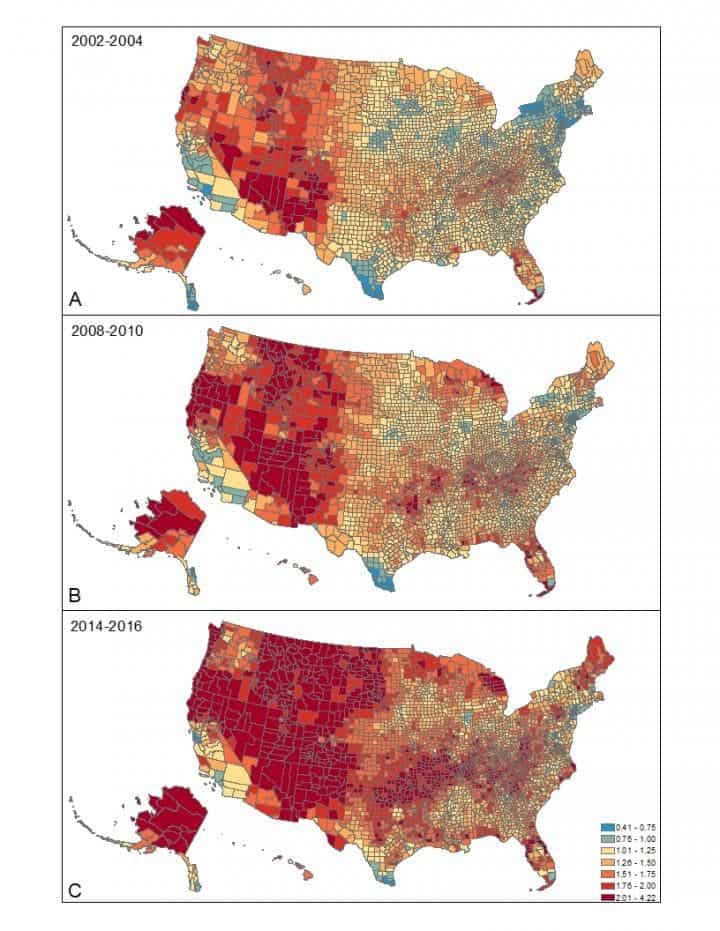Suicide is, sadly, becoming more common in America, especially in rural areas.

A new study from The Ohio State University found that suicide rates jumped by 41%, from an average of 15 per 100,000 residents to 21.2 per 100,000 between 2014 and 2016. The study evaluated national suicide data from 1999 to 2016 to provide a county-by-county picture of the suicide toll among adults.
It also highlights a cluster of factors, including lack of insurance and the prevalence of gun shops, that are associated with high suicide rates.
Highest where life is hardest
“While our findings are disheartening, we’re hopeful that they will help guide efforts to support Americans who are struggling, especially in rural areas where suicide has increased the most and the fastest,” said lead researcher Danielle Steelesmith, a postdoctoral fellow at Ohio State’s Wexner Medical Center.
The study found that suicide rates were highest in the least-populous counties of the US, and in the areas where people have the lowest income and most limited access to resources. From 2014 through 2016, suicide rates were 17.6 per 100,000 in large metropolitan counties compared with 22 per 100,000 in rural counties. In urban areas, the team adds, counties with more guns shops tended to have higher rates of adult suicide.
All in all, counties in Western states including Colorado, New Mexico, Utah, and Wyoming tended to have the highest rates of suicide, as did the Appalachian states of Kentucky, Virginia, West Virginia, and those in the Ozarks, including Arkansas and Missouri.
“Suicide is so complex, and many factors contribute, but this research helps us understand the toll and some of the potential contributing influences based on geography, and that could drive better efforts to prevent these deaths,” said Steelesmith.
The study analyzed 453,577 suicides by adults (25 to 64 years old) from 1996 to 2016. Suicides were most common among men and those 45 to 54 years old. The team says adult suicide rates have increased between 2014 and 2016 despite a national prevention effort that kicked off in 2015, which aimed to reduce suicide rates by 20% by 2025.

The findings can help guide and bolster the effectiveness of suicide prevention efforts says Cynthia Fontanella, a study co-author and associate professor of psychiatry and behavioral health at Ohio State.
“For example, all communities might benefit from strategies that enhance coping and problem-solving skills, strengthen economic support and identify and support those who are at risk for suicide,” Fontanella said.
She adds that the link between urban gun shops and higher suicide rates suggests they can be targeted to reduce access to the means people use to commit suicide. In rural areas, “deprivation” was a closely-related factor to suicide rates. Deprivation includes a cluster of conditions including underemployment, poverty, and low educational attainment.
Long-term and persistent poverty may be more entrenched in rural areas, the team explains, and economic opportunities more limited. Steelesmith adds that many rural Americans rely on jobs in agriculture and industries like coal mining, which are dwindling. They also suffer from a lack of support services that they may turn to in their time of need.
“In cities, you have a core of services that are much easier to get to in many cases. You may have better access to job assistance, food banks and nonprofits that might all contribute to less desperation among residents,” Steelesmith said.
High social fragmentation — which factors in levels of single-person households, rates of unmarried residents, and the impermanence of residents — and low social capital were also particularly pronounced in rural America, the team explains. Social capital is a measure of how connected or closely-knit a given society is.
Other factors associated with higher suicide rates included high percentages of veterans in a county and lower rates of insurance coverage.
Fontanella explains that people who live in rural America would particularly benefit from strategies designed to promote social connections. Community engagement activities that give residents the chance to interact and to become familiar with supportive resources in their area would be a good approach. Steelesmith adds that some states, particularly in the West, have large counties with great variability in terms of resident life experiences, for instance, so solutions need to be tailored for individual communities.
The paper “Contextual Factors Associated With County-Level Suicide Rates in the United States, 1999 to 2016” has been published in the journal JAMA Network Open.


